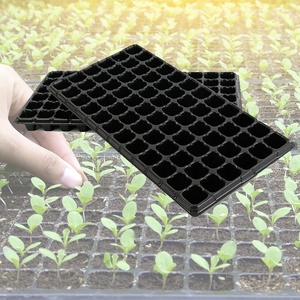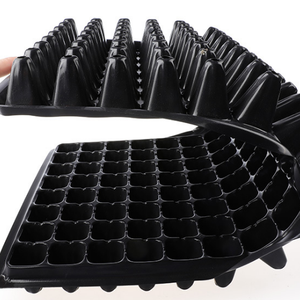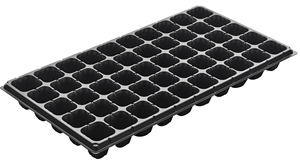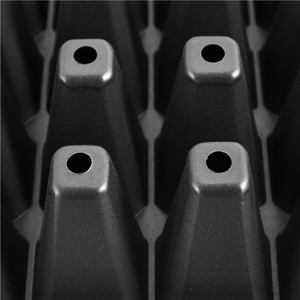(2354 products available)























































































































































































































There are different kinds of 72 cell seed trays. Each kind has special features. They are suitable for different planting needs. Some are made of plastic. Others use bio-degradable materials. Some have drainage holes for water flow. Some come with covers to keep humidity in. These seed trays help seeds grow better. They support seedlings. They prepare them for transplanting into gardens or farms.
Plastic seed trays
Plastic seed starting trays are durable. They last a long time. They are easy to clean and reuse. They have standard sizes. They are compatible with other grow equipment. Plastic trays have good drainage. They provide consistent moisture to seedlings. They are a popular choice for home and commercial gardeners.
Fiber seed trays
Fiber seed trays are eco-friendly. They are made from recycled paper pulp. They decompose naturally in soil. They reduce environmental impact. Fiber seed trays are designed to be biodegradable. They break down when exposed to soil microorganisms. They are good for organic gardening. They avoid chemical treatments. They support sustainability.
Injection molded seed trays
Injection molded seed trays are made from plastic. They are formed using an injection molding process. This process makes them very strong. It creates a solid structure. These trays can handle heavy soil. They can support many plants. They work well for big farms or businesses. They need trays that will not break. The trays have clear cell designs. They match different planting needs.
Biodegradable seed trays
These seed trays are made from natural materials. They include bamboo, sugarcane, or compostable bioplastics. They break down safely in compost. They reduce waste in landfills. These trays support eco-friendly gardening. They are good for people who want to protect nature. They do not use plastic. They are suitable for home gardens. They also work for schools and research projects.
Modular seed trays
Modular seed trays have a tray-and-cell design. The cells can be removed or rearranged. This design makes planting and transplanting easier. It reduces root disturbance. Modular trays are good for growing different plants. They can quickly change the layout. They are suitable for commercial nurseries. They are also good for research labs.
The design of these seed trays has made them a must-have for gardeners. They are a practical solution for starting seeds.
The design of the 72 cell seed trays focuses on efficiency, durability, and ease of use. They provide a reliable way to grow seedlings. They prepare gardeners for transplanting into larger outdoor gardens. Their design meets the needs of casual home gardeners and large-scale agricultural operations.
Commercial greenhouses
Greenhouses use these trays to grow many seedlings for vegetables like tomatoes, peppers, and cucumbers. The trays give a consistent growing environment, and the seedlings are strong for transplanting.
Nursery and garden centers
These centers use seed trays to grow plants for customers. They can start flowers, herbs, and ornamental plants and sell them as ready-to-plant seedlings.
Research laboratories
In plant biology studies, scientists use seed trays to grow different plants under controlled situations. This helps with studies on plant growth, disease resistance, and gene transfer.
Educational institutions
Schools and colleges use seed trays in agriculture and biology classes. Students learn about plant care, transplanting, and the factors affecting plant growth.
Horticultural therapy programs
These programs use gardening to help people mentally and socially. Small seed trays are good for these programs because they allow participants to grow a range of plants in a small space.
Urban gardening and rooftop gardens
People in cities with limited space use these seed trays to start seedlings. The trays can grow many plants in a small space. They are good for growing vegetables in urban areas.
Research on sustainable agriculture
Scientists studying eco-friendly farming methods use seed trays to grow crops within controlled settings. Trays support studies on water-saving irrigation systems and organic farming methods.
Aquaponics and hydroponics systems
Seed trays are used as plant support in aquaponics and hydroponics. These systems supply nutrients directly to the seedlings growing in the trays.
Restoration projects
Seed trays grow native plants for habitat restoration and conservation. Using seed trays to grow plants for reintroducing them into their natural habitats is helpful.
Business buyers need to consider the following factors when selecting seed trays for their greenhouse or horticultural business.
Target Plants
Consider the target plants and their specific germination and transplanting needs. Choose seed trays with cell sizes that match the root development of seeds and seedlings. For example, select larger cells for tomatoes and peppers, which need more root space. Also, consider how quickly the plants will grow. Fast-growing plants may need larger cell trays to avoid root crowding.
Durability and Material
Choose trays made from durable materials like ABS plastic or recycled PVC. These materials can withstand the stresses of commercial use. Also, consider trays made from biodegradable materials like coconut coir for customers wanting eco-friendly options. These biodegradables break down naturally and reduce environmental impact.
Manufacturers and Standards
Choose seed trays made by manufacturers who comply with industry standards. Look for trays that meet GGSDA and ASTM standards for quality and safety. Selecting trays made by trusted manufacturers protects business buyers and their customers from defects and safety issues.
Ease of Use
Choose seed trays that are easy to use and maintain. Look for features like smooth surfaces for simple cleaning and alignment. Trays with uniform cell sizes and shapes make filling and transplanting more efficient. Also, consider ordering trays that work with existing irrigation and handling systems to reduce the need for extra equipment.
Supplier Reliability
Choose suppliers who deliver seed trays on time and maintain consistent quality. Check reviews and ratings to assess supplier performance. Also, consider suppliers who offer flexible order sizes. These suppliers can adjust orders quickly to meet demand changes.
Cost and Budget
Balance the seed tray quality with the budget. Think about the long-term value of features like durability, ease of use, and ecological impact. Choose trays that last for many planting seasons, even if they cost more upfront. Consider the return on investment for eco-friendly trays that attract customers concerned about their environmental footprint.
Q1: What are the benefits of using 72 cell seed trays?
A1: 72 cell seed trays offer efficient space utilization, uniform moisture distribution, easy transplanting, and scalability, making them ideal for growing a large number of identical plants.
Q2: Which seeds are most suitable for 72 cell seed trays?
A2: Nearly all vegetable, herb, flower and ornamental plant seeds can thrive in 72 cell seed trays. However, it is advisable to start with small-seeded plants.
Q3: What soil should be used in 72 cell seed trays?
A3: A light, well-draining potting mix that retains some moisture is ideal for seed germination in 72 cell seed trays.
Q4: How can drainage be ensured in 72 cell seed trays?
A4: Choose seed trays with holes at the bottom to allow excess water out and prevent overwatering.
Q5: What is the procedure for transplanting seedlings from 72 cell seed trays?
A5: The procedure involves hardening off the seedlings, gently loosening them, and replanting them into larger transplant holes.